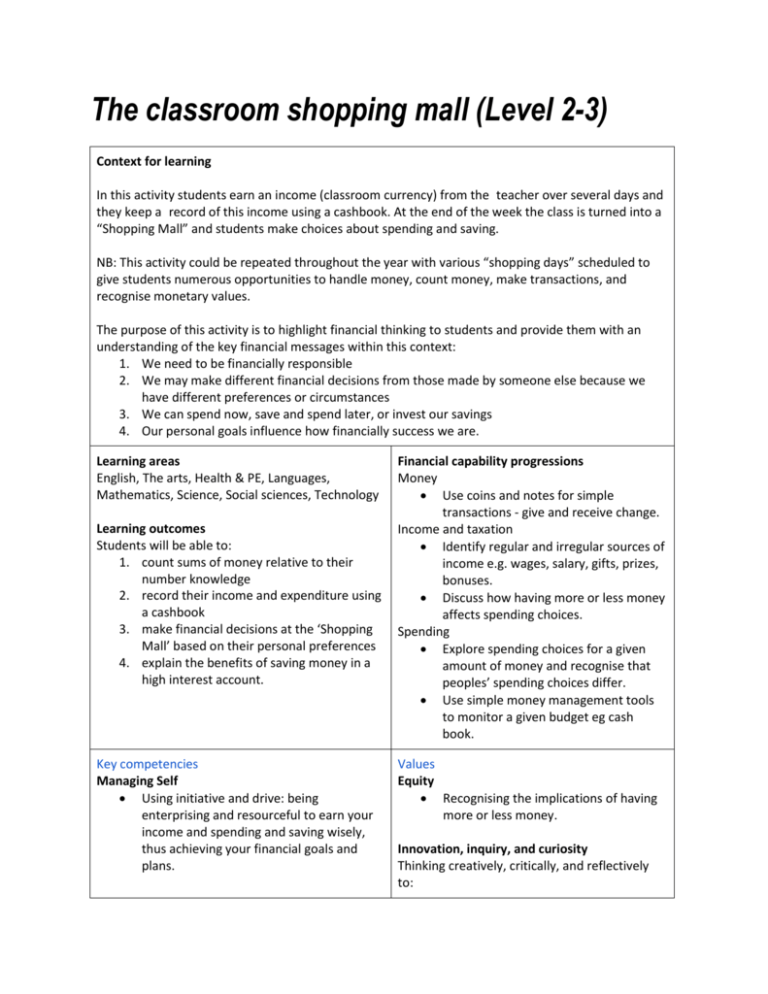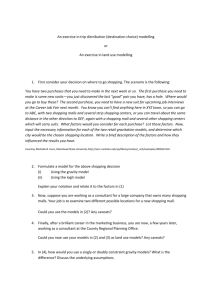The classroom shopping mall
advertisement

The classroom shopping mall (Level 2-3) Context for learning In this activity students earn an income (classroom currency) from the teacher over several days and they keep a record of this income using a cashbook. At the end of the week the class is turned into a “Shopping Mall” and students make choices about spending and saving. NB: This activity could be repeated throughout the year with various “shopping days” scheduled to give students numerous opportunities to handle money, count money, make transactions, and recognise monetary values. The purpose of this activity is to highlight financial thinking to students and provide them with an understanding of the key financial messages within this context: 1. We need to be financially responsible 2. We may make different financial decisions from those made by someone else because we have different preferences or circumstances 3. We can spend now, save and spend later, or invest our savings 4. Our personal goals influence how financially success we are. Learning areas English, The arts, Health & PE, Languages, Mathematics, Science, Social sciences, Technology Learning outcomes Students will be able to: 1. count sums of money relative to their number knowledge 2. record their income and expenditure using a cashbook 3. make financial decisions at the ‘Shopping Mall’ based on their personal preferences 4. explain the benefits of saving money in a high interest account. Key competencies Managing Self Using initiative and drive: being enterprising and resourceful to earn your income and spending and saving wisely, thus achieving your financial goals and plans. Financial capability progressions Money Use coins and notes for simple transactions - give and receive change. Income and taxation Identify regular and irregular sources of income e.g. wages, salary, gifts, prizes, bonuses. Discuss how having more or less money affects spending choices. Spending Explore spending choices for a given amount of money and recognise that peoples’ spending choices differ. Use simple money management tools to monitor a given budget eg cash book. Values Equity Recognising the implications of having more or less money. Innovation, inquiry, and curiosity Thinking creatively, critically, and reflectively to: Participating and contributing Planning and organising: setting financial goals, establishing budgets, establishing a timeline, making decisions, etc. set and achieve personal financial goals analyse and solve financial problems. Integrity Making responsible financial decisions. Using language, symbols and texts Communicating and receiving ideas and information: using financial language and exchanging financial information and ideas between relevant people. Collecting, organising and analysing information: gathering financial and other applicable information, and then making sense of it to support good financial decision making that stands the test of time. Resource requirements Envelopes Cash book template Vouchers Donated toys, games and books Tickets for pricing Class bank Classroom specimen currency Specimen currency is available from School Supplies to support Mathematics learning. Order at: http://www.schoolsupplies.co.nz Teaching and learning sequence 1. The teacher explains that they are going to reward students with an income over the next few days for their hard work. Students may be paid for completing their homework, having a tidy desk, working hard in class, using good manners, carrying out classroom duties, etc. NB: The denominations of currency that the teacher uses will be determined by students’ number knowledge – if students are still exploring numbers between 1 and 20 then they will be best paid with $1 and $2 coins; if students are able to recognise that 2 fifty cents make $1 or that 5 twenty cents make $1 then these lesser valued coins could be used. 2. Students store their income in a safe place and keep a record of their income using a simple cashbook (see attached resource sheet). 3. The teacher asks the students to bring along unwanted toys, games and books from home to sell at the “Classroom Shopping Mall” at the end of the week. As items are brought to school they are displayed on a table so that everyone can see what will be available at ‘the shops’. The teacher develops vouchers that will also be up for sale. Vouchers could be for free time on the computer; a trip to the school library with a friend; playground time; free time at the painting easel, etc. These are also displayed. 4. The teacher and students view everything that will be up for sale at the “Classroom Shopping Mall” and group items into different categories, e.g. soft toys, fiction books, non fiction books, figurines, toy cars, board games, jigsaws, vouchers, etc. The teacher and students set the items up around the room at different shopping stations. 5. The class explores what items are the most popular and the most valuable and they work together to establish a price for each item. The class will also calculate how much students have to spend before setting prices. Price tickets are written with the correct symbols and they are attached to the different products. 6. The ‘shopping day’ is held. The students take turns to be a shopper and a store attendant. These roles might be role modelled before the shop opens. The ‘buying’ student records their purchase/s in their cashbooks. NB: The teacher will need to decide if the revenue from the goods is returned to the particular students who donated them OR if all the money from the ‘shopping day’ is placed in a classroom bank. If money is returned to students, individual sales will need to be recorded. This could be achieved by recording sold on the price ticket, which has the name of the student who provided the goods on the back. a. Explain to students that they do not have to spend all of their money on this particular ‘shopping day’. They might want to save their money for a future ‘shopping day’ and have more money for this subsequent event. b. You could set up a classroom bank that offers a high interest savings account for the students if they choose to save some of their money. c. You could promote long term savings to students by having ‘expensive’ and highly desirable items on offer that students will need to save for. d. As students become familiar with certain denominations of money you can introduce different coins to promote the development of students’ number knowledge, e.g. move from adding whole dollar denominations together to adding amounts with 50 cents, etc. Reflective questions 1. Students share their income and expenditure records with their peers and describe how they feel about the financial decisions that they made at the ‘Classroom Shopping Mall.’ What financial personality do students think they have, “I see, I want, I buy... everything”, “I want to save my money”, “I want to think carefully before I buy”. Or do you think you have another? 2. In what ways do you think you were financially responsible? 3. Did all the students make the same financial decisions, or were some of the decisions different? 4. Why were some goods in the ‘Shopping Mall’ more expensive than others? Did you have a lot of money to spend on the ‘shopping day’ or not a lot? How did this make you feel? 5. Can you think of other ways that you could earn some classroom specimen currency from your teacher? 6. Did you put some of your income into a high interest savings account? Why or why not? 7. What key financial messages can we write for our display wall?







